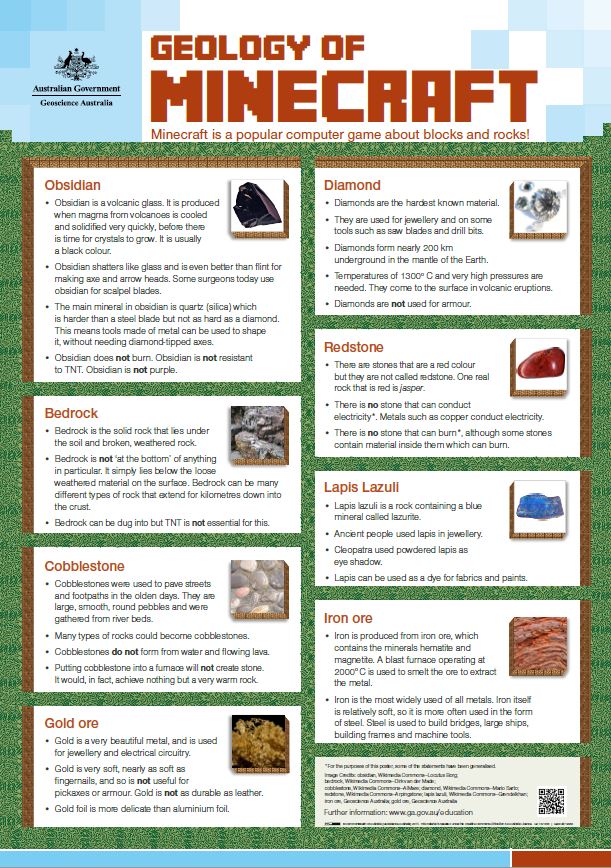Minerals
Type of resources
Keywords
Publication year
Service types
Topics
-

A colour poster comparing the concepts in the computer game Minecraft with the geology of particular minerals and rocks. Aimed at school children, for display in classrooms. Designed to be printed at A2, but can also be printed smaller.
-

A second colour poster comparing the concepts in the computer game Minecraft with particular minerals and rocks. Aimed at school children, for display in classrooms. Designed to be printed at A2, but can also be printed smaller.
-
Australia's Identified Mineral Resources is an annual national assessment that takes a long-term view of Australian mineral resources likely to be available for mining. The assessment also includes evaluations of long-term trends in mineral resources, world rankings, summaries of significant exploration results and brief reviews of mining industry developments.
-
Publicly available geological data in the Adavale Basin region are compiled to produce statements of existing knowledge for natural hydrogen, hydrogen storage, coal and mineral occurrences. This data guide also contains an assessment of the potential for carbon dioxide (CO2) geological storage and minerals in the basin region. Geochemical analysis of gas samples from petroleum boreholes in the basin shows various concentrations of natural hydrogen. However, the generation mechanism of the observed natural hydrogen concentration is still unknown. The Adavale Basin also has the potential for underground hydrogen storage in the Boree Salt. Given the depth of the Boree Salt (wells have intersected the salt at depths below 1800 m) and the high fluid pressure gradient in the basin, the construction of underground salt caverns should include consideration of stability and volume shrinkage. Mineral occurrences are all found in the basins overlying the Adavale region. However, they are small (thousands of tonnes range) and not currently of economic interest. The Adavale Basin has potential for base and precious metal deposits due to suitable formation conditions, but the depth of the basin makes exploration and mining difficult and expensive. There are no identified occurrences or resources of coal in the Adavale Basin. Given the depth of the basin, extraction of any identified coal would probably be uneconomic, with the potential exception of coal seam gas extraction. An assessment of CO2 geological storage also shows prospective storage areas in the Eromanga Basin within the Adavale Basin region in the Namur-Murta and Adori-Westbourne play intervals.
-
<div>This look-book was developed to accompany the specimen display in the office of the Hon Madeleine King MP, Minister for Resources and Northern Australia. It contains information about each of the specimens including their name, link to resource commodities and where they were from. </div><div><br></div><div>The collection was carefully curated to highlight some of Australia’s well known resources commodities as well as the emerging commodities that will further the Australian economy and contribute to the low energy transition. The collection has been sourced from Geoscience Australia’s National Mineral and Fossil Collection. </div><div><br></div><div>The collection focuses on critical minerals, ore minerals as well as some fuel minerals. These specimens align with some of Geoscience Australia major projects including the Exploring For the Future (EFTF) program, the Trusted Environmental and Geological Information program (TEGI) as well as the Repository and the public education and outreach program. </div>
-
How do some of the rocks in Minecraft form and behave in real life? This short video discusses bedrock, obsidian and redstone using real rock samples and references to the game.
-
This web map service provides location information and details about commodities exported from shipping ports around Australia. This dataset has been collated by Geoscience Australia from publicly available information as a guide only.
-
Australia - Offshore Minerals Act 1994 - Mineral Blocks - epoch 2014a. This service displays the Australian Mineral Blocks - Aligned with the current Australian Maritime Boundary Dataset. Refer to the metadata of the geodatabase for a detailed abstract relating to the data.
-
Statements of existing knowledge are compiled for known mineral, coal, hydrocarbon and carbon capture and storage (CCS) resources and reserves in the north Bowen Basin. This data guide illustrates the current understanding of the distribution of these key resource types within the north Bowen Basin region based on trusted information sources. It provides important contextual information on the north Bowen Basin and where additional details on discovered resources can be found. The north Bowen Basin contains 17 metallic mineral deposits, with the majority containing gold. The basin also contains 152 thermal and metallurgical coal deposits. Most coal deposits contain metallurgical coal. This basin contains most of Queensland’s metallurgical coal resources, although many of the deposits supply a mix of thermal and metallurgical coal (Blake et al., 2018). The north Bowen Basin hosts very large coal tonnages, with known black coal resources of approximately 47 billion tonnes. Significant hydrocarbon resources are known to exist in the basin, the majority being coal seam gas (CSG). The basin contains more limited reserves and resources of conventional oil and gas and oil shale. At this time, there are no active or planned CCS projects in the basin.
-
This mineral collection comprises 13,000+ locality based museum quality specimens derived from BMR/AGSO/GA field survey programs, from external organisations (e.g. Australian Museums, state geological surveys), or from donations or bequests by private collectors. It includes specimens from all over the world with a strong emphasis on minerals from Broken Hill.
